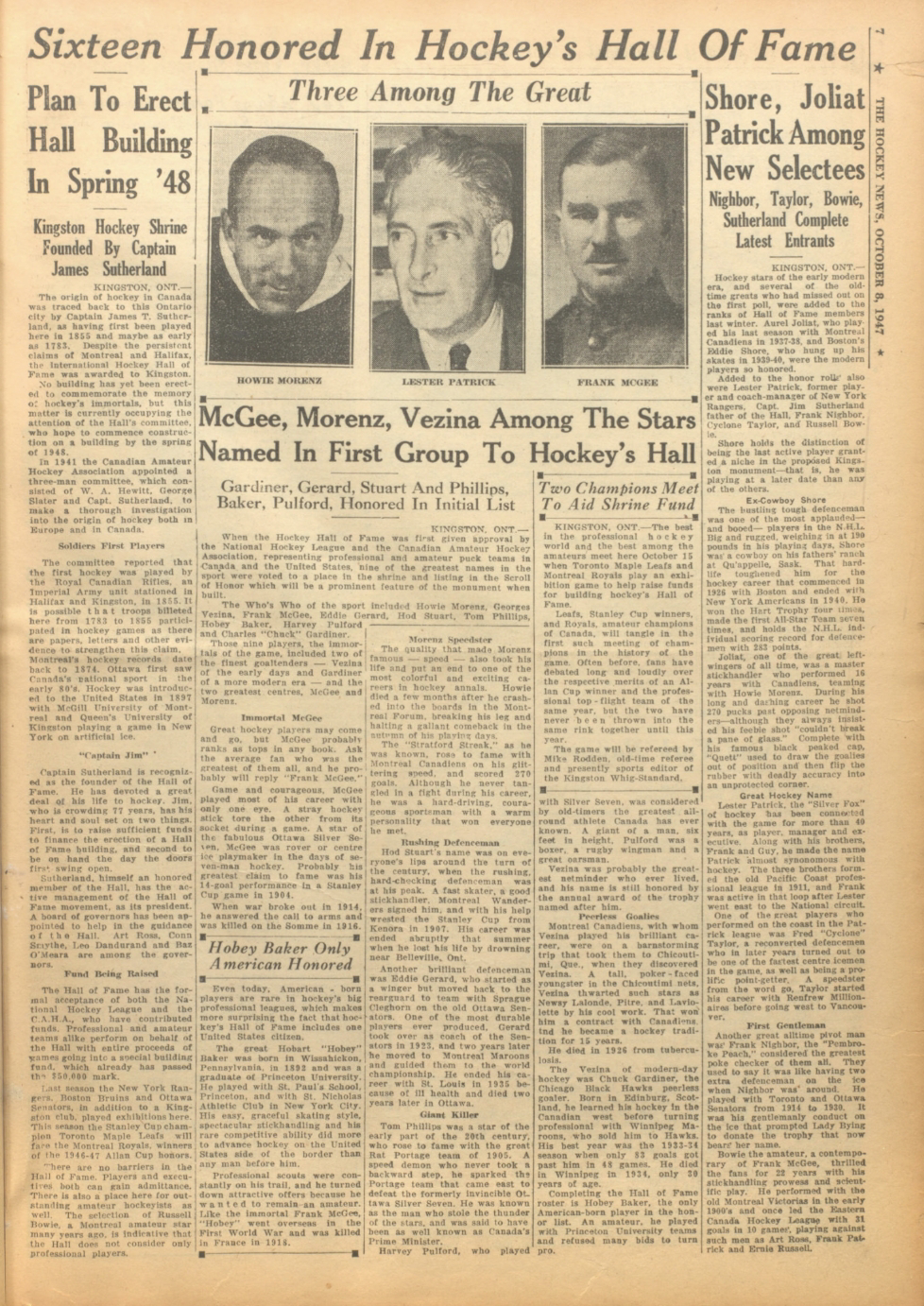Everything is so well documented in the past 30-40 years, both in digitized print and especially video. One day a kid will be curious to see for him or her self who was better - Sidney Crosby or Alex Ovechkin - and will go to YouTube and decide for him or herself. Or read endless amounts of data, or listen to past audio. It's a complete treasure trove that they take for granted and we wish existed many years prior.
The earliest days of hockey have and always will be very scarcely covered, with first hand accounts all but disappeared already.
Take, for example, the earliest stars of the game. There's not too many people alive today who can claim to have seen any of them play. There is no YouTube for Frank McGee, Howie Morenz or Georges Vezina.
In the very second issue of THN there is a full page feature on the 1947 announcement of the Hockey Hall of Fame construction and the announcement of the newest inductees. While no credit is given to who wrote the article, we can assume that first hand accounts of the players were not as hard to come by back then.
Let's take a look at how they described some of the players, starting with their look back at the inaugural class of 1945, a class that honoured mostly hockey stars who died early:
Frank McGee is described as "immortal." He is described as game and courageous, a nod to his fantastic hockey career despite only have one eye due to an errant stick early in his career, as well as his stature of World War I hero even though he never returned home, killed on the Somme in 1918.
Howie Morenz was not surprisingly lauded for his speed and flair, but was also described as "a hard driving, courageous sportsmen with a warm personality that won everyone he met.
Hod Stuart is not a name that most people remember nowadays, but there was a time when "Hod Stuart's name was on the lips around the turn of the (20th) century when the rushing, hard-checking defenseman was at his peak." He was also noted as "a fast skater, a good stickhandler," but like fellow inductees McGee, Morenz, Georges Vezina, Charlie Gardiner and Hobey Baker, lost his life early due to a summertime drowning accident.
"Another brilliant defenseman" was Eddie Gerard. He "started as a winger but moved back to the rearguard to team with Sprague Cleghorn on the old Ottawa Senators." He was also noted as "one of the most durable players ever produced." He, too, died young after retiring and then embarking on a promising coaching career.
"Giant Killer" Tommy Phillips was described as "a speed demon who never took a backward step. He was known as the man who stole the thunder of the stars, and was said to have been as well known as Canada's Prime Minister."
Then there was Harvey Pulford, "known by the oldtimers as the greatest all-round athlete Canada has ever known. A giant of a man, Pulford was a boxer, a rugby wingman and a great oarsman."
Georges Vezina may be the most recognizable name nowadays, if only because his name is attached to the NHL's award for top goaltender. Of course, the "tall, poker-faced youngster" was once one of the greats himself. He starred with the Montreal Canadiens for 15 years before dying in 1926 from tuberculosis.
New York Rangers puck stopper Charlie Gardiner had a similar story with a similar early demise. He was described as peerless.
Last but not least is the American amateur Hobey Baker, who refused many pro offers to keep his amateur status.
The Hockey News then jumped to the 1947 inductees:
"Ex-Cowboy" Eddie Shore was "the bustling tough defenseman" and "one of the most applauded - and booed - players in the NHL. "The hard life toughened him for the hockey career." He won the Hart Trophy 4 times, was named a First All Star 7 times and held the individual scoring record for defensemen." Both his scoring exploits and violent outbursts are still known to this day.
"One of the greatest left wingers of all time" was Aurel Joliat. "A master stickhandler," he performed 16 years with the Montreal Canadiens, notably alongside Howie Morenz. He scored 279 times despite having "a feeble shot that couldn't break a pane of glass." But the man who wore the black cap "used to draw the goalies out of position and then flip the rubber with deadly accuracy into the unprotected corner."
"Another great all time pivot man was Franky Nighbor, the Pembroke Peach, considered the greatest poke checker of them all. They used to say it was like having two extra defensemen on the ice when Nighbor was around. It was his gentlemanly conduct on the ice that prompted Lady Byng to donate the trophy that now bears her name."
Russell Bowie "thrilled fans for 22 years with his stickhandling prowess and scientific play." He is probably the least well known player of this induction class.
"Cyclone" Taylor was "a reconverted defenseman who in later years turned out to be one of the faster center icemen in the game, as well as a prolific point getter." Of course, Taylor's speed was was mentioned.
Lester Patrick was honoured by the Hockey Hall of Fame as a player in 1947, but interestingly even back then his playing career was already overshadowed by his coaching and executive career. He and brother Frank are among the very most important builders in the history of the game.


No comments:
Post a Comment